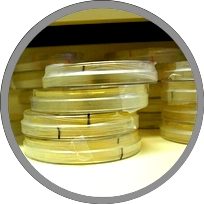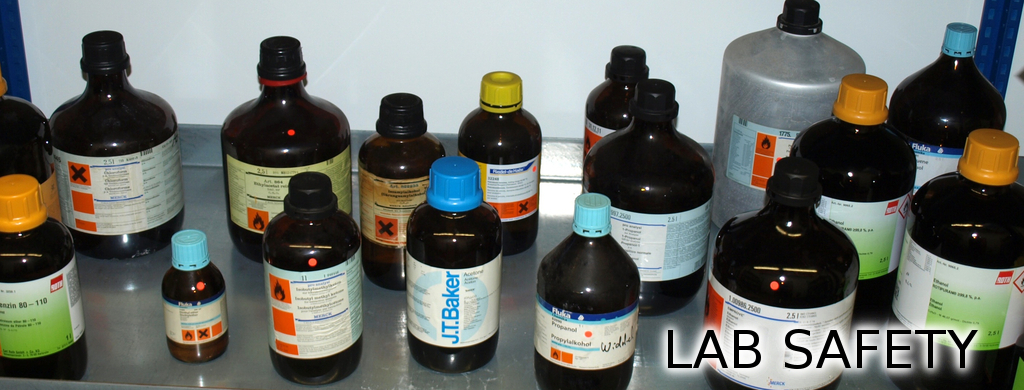Team:LMU-Munich/Laboratory Safety
From 2012.igem.org
| (3 intermediate revisions not shown) | |||
| Line 1: | Line 1: | ||
<!-- Include the next line at the beginning of every page --> | <!-- Include the next line at the beginning of every page --> | ||
{{:Team:LMU-Munich/Templates/Page Header|File:Team-LMU_agar_plates.resized.jpg|5}} | {{:Team:LMU-Munich/Templates/Page Header|File:Team-LMU_agar_plates.resized.jpg|5}} | ||
| - | [[File: | + | [[File:Lab safety banner.resized WORDS.JPG|600px]] |
| - | |||
| - | |||
Here you find our considerations on the following topics of biological safety for our project: | Here you find our considerations on the following topics of biological safety for our project: | ||
| Line 27: | Line 25: | ||
<b> 4) Do you have any other ideas how to deal with safety issues that could be useful for future iGEM competitions? How could parts, devices and systems be made even safer through biosafety engineering?</b> | <b> 4) Do you have any other ideas how to deal with safety issues that could be useful for future iGEM competitions? How could parts, devices and systems be made even safer through biosafety engineering?</b> | ||
| - | + | ||
<div class="box"> | <div class="box"> | ||
| Line 51: | Line 49: | ||
<p align="justify"> | <p align="justify"> | ||
| - | The other subproject, [[Team:LMU-Munich/Spore_Coat_Proteins|'''Sporo'''bead]] involves the creation of GMOs which have unknown effects to the public or the environment. Although we have great plans for the use of our | + | The other subproject, [[Team:LMU-Munich/Spore_Coat_Proteins|'''Sporo'''bead]] involves the creation of GMOs which have unknown effects to the public or the environment. Although we have great plans for the use of our '''Sporo'''beads, they never leave our laboratory, so they cannot harm the public or environment. For possible future applications, we will prevent the germination of our '''Sporo'''beads in two different ways ([[Team:LMU-Munich/Germination_Stop|'''Germination'''Stop]]), so that they cannot proliferate. This is our approach towards the safety of our '''Sporo'''beads. |
</p> | </p> | ||
<p align="justify"> | <p align="justify"> | ||
| - | We have not worked on it yet, but there also is the possibility to remove antibiotic resitance genes from the ''Bacillus subtilis'' genome (for example with [https://static.igem.org/mediawiki/2012/6/6d/LMU-Munich_2012_Clean_deletions_in_Bacillus_subtilis.pdf pMAD], a vector that we used to delete genes in ''B. subtilis''). All of our constructs are used while being integrated into the genome. Therefore all resistances could be removed (without removing the functional constructs) before the use of the | + | We have not worked on it yet, but there also is the possibility to remove antibiotic resitance genes from the ''Bacillus subtilis'' genome (for example with [https://static.igem.org/mediawiki/2012/6/6d/LMU-Munich_2012_Clean_deletions_in_Bacillus_subtilis.pdf pMAD], a vector that we used to delete genes in ''B. subtilis''). All of our constructs are used while being integrated into the genome. Therefore all resistances could be removed (without removing the functional constructs) before the use of the '''Sporo'''beads. Other pathogens would thereby not have the possibility to grab resistance genes from our strains. |
</p> | </p> | ||
| Line 85: | Line 83: | ||
The general safety rules are listed [https://static.igem.org/mediawiki/2011/7/77/GenBetriebsanweisungS1_english.pdf here] (This file is derived from Göttingen University, but the rules are identical.) | The general safety rules are listed [https://static.igem.org/mediawiki/2011/7/77/GenBetriebsanweisungS1_english.pdf here] (This file is derived from Göttingen University, but the rules are identical.) | ||
</p> | </p> | ||
| + | </div> | ||
| - | + | <div class="box"> | |
<b>Question 4</b> | <b>Question 4</b> | ||
| - | |||
| - | |||
<p align="justify"> | <p align="justify"> | ||
One part is the removal of resistance cassettes (not possible in organsims that have plasmids). We also like the toxin-antitoxin system described by Cambridge last year. | One part is the removal of resistance cassettes (not possible in organsims that have plasmids). We also like the toxin-antitoxin system described by Cambridge last year. | ||
Latest revision as of 14:15, 26 October 2012

The LMU-Munich team is exuberantly happy about the great success at the World Championship Jamboree in Boston. Our project Beadzillus finished 4th and won the prize for the "Best Wiki" (with Slovenia) and "Best New Application Project".
[ more news ]

Here you find our considerations on the following topics of biological safety for our project:
1) Would any of your project ideas raise safety issues in terms of:
- a) researcher safety?
- b) public safety?
- c) environmental safety?
2) Do any of the new BioBrick parts (or devices) that you made this year raise any safety issues? If yes,
- a) did you document these issues in the Parts Registry?
- b) how did you manage to handle the safety issue?
- c) How could other teams learn from your experience?
3) Is there a local biosafety group, committee, or review board at your institution?
- a) If yes, what does your local biosafety group think about your project?
- b) If no, which specific biosafety rules or guidelines do you have to consider in your country?
4) Do you have any other ideas how to deal with safety issues that could be useful for future iGEM competitions? How could parts, devices and systems be made even safer through biosafety engineering?
Answers:
In general:
To assure safe working practice throughout the competition, every team member participated in a general safety meeting regarding good laboratory practice and working with genetically modified organisms (GMOs), including storage and disposal. We work only with non-hazardous, non-pathogenic organisms like Escherichia coli (lab strain XL1 blue) and Bacillus subtilis (W168). We follow the safety regulations that apply for the [http://en.wikipedia.org/wiki/Biosafety_level#Biosafety_level_1 biological safety level 1] classification. That means we wear lab coats and single-use gloves. When working with hazardous chemicals (e.g. liquid N2) we wear goggles as well. Furthermore, dangerous substances are stored and handled in designated rooms in order to assure the safety of the researchers.
For the protection of the public and the environment against hazardous substances, all GMO-contaminated waste is inactivated by autoclavation. Before leaving the laboratory, every researcher cleans and disinfects his/her hands. Moreover, we leave the windows closed and do not discard any dangerous substances in the sink.
Question 1
The subproject BacillusBioBrickBox is about the construction and evaluation of new BioBricks for the work with B. subtilis (see Answer 2) and therefore does not raise any safety issues.
The other subproject, Sporobead involves the creation of GMOs which have unknown effects to the public or the environment. Although we have great plans for the use of our Sporobeads, they never leave our laboratory, so they cannot harm the public or environment. For possible future applications, we will prevent the germination of our Sporobeads in two different ways (GerminationStop), so that they cannot proliferate. This is our approach towards the safety of our Sporobeads.
We have not worked on it yet, but there also is the possibility to remove antibiotic resitance genes from the Bacillus subtilis genome (for example with pMAD, a vector that we used to delete genes in B. subtilis). All of our constructs are used while being integrated into the genome. Therefore all resistances could be removed (without removing the functional constructs) before the use of the Sporobeads. Other pathogens would thereby not have the possibility to grab resistance genes from our strains.
From the best of our knowledge, the parts, strains and spores we use do not raise any safety concerns. However a point that needs to be discussed here is the potential risk of misusing our spores. We offer an easy platform for displaying any protein of interest on our spores. Could this platform be used by e.g. a bio-terrorist? Since all information on how to build a spore with a protein of interest is given on this website, one could imagine to use Sporobeads as a vehicle for lethal proteins. Our team is aware of this potential risk. However, our spores can not germinate, so the risk of a rapidly spreading epidemic is negligible. Today it still seems "easier" to use directly know pathogens like e.g. Helicobacter pylori. Furthermore, the toxin will be the toxic part, not our spore.
Question 2
Our Biobricks contain promotors, regulators, a bacterial toxin and reporter genes. None of them are able to cause illnesses or threaten humans in any other way. All inserts are also derived from non-pathogenic, non-hazardous organisms. The amplified and cloned fragments again belong to the GMO safety class S1.
Question 3
We did an interview with the Safety Commissioner Dr. Schubar who is responsible for the LMU-Munich. He confirmed that we are working with a safe strain (B. subtilis W168 which has a tryptophan auxotrophy) and are only using safe plasmids, genes and promoters. He is not in a position to allow the release of our spores, but according to the present law, it should be allowed. At the moment, there are ongoing discussions for a SynBio law which is not yet established. For details, please have a look at our interview.
Germany has signed and ratified the [http://www.cbd.int/doc/legal/cartagena-protocol-en.pdf Cartagena Biosafety Protocol]. This protocol ensures safe handling, use and transfer of genetically modified organisms. Furthermore, we have our own laws and guidelines for biosafety here. For example, all laboratories which are handling GMOs have a designated biosafety level, which is stated in a genetic engineering decree ([http://www.gesetze-im-internet.de/bundesrecht/gentsv/gesamt.pdf Gentechnik Sicherheitsverordnung]) and monitored by university officials.
The general safety rules are listed here (This file is derived from Göttingen University, but the rules are identical.)
Question 4
One part is the removal of resistance cassettes (not possible in organsims that have plasmids). We also like the toxin-antitoxin system described by Cambridge last year.
Our project offers a new, safe platform for various applications. Similar to virus ghosts, our spores are non-proliferative capsules and therefore are safer to work with than vegetative cells. Part of the GerminationSTOP is the Suicideswitch (see GerminationSTOP) which yields a toxin during sporulation and therefore kills the cell upon germination. This is a device dedicated to make our Sporobeads safe. But if linked to another promotor, the switch could be turned on in other cases and be used to make other systems safer.
 "
"




